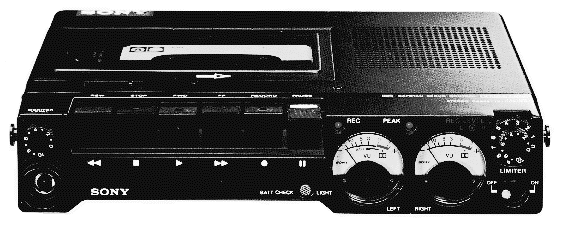![]()
![]()

Since 1975, The Film Group has offered filmmakers high-quality, low-cost alternatives to the more conventional forms of motion picture sync sound production equipment.
With the popularity of our original mono with sync conversions for analog cassette recorders it was only a matter of time before our customers began asking us for a conversion that would not use up one of the stereo channels for the sync signal. In other words, they wanted a stereo with sync recorder. In response we developed what we call our StereoSync System to meet their needs.
Using the Sony TC-D5M or the TC-D5ProII audio cassette recorder as a base, we have developed a sync sound conversion that retains the original stereo format while providing a recoverable sync signal for resolving later.
The TC-D5M/ProII comes from a long line of D5 series recorders. They have a proven track record of high quality sound and excellent durability. Our mono with sync conversions have been used all over the world in every possible climatic environment with remarkable results.
The Stereosync System consists of a "modified pilotone" 30hz. crystal sync generator. This generator is placing a redundant sync signal reference on both the left and right channels at approximately -45dB down. To prevent program audio from damaging this low level sync signal, an active 30hz. notch filter has been installed within each channel preamp. This filter provides a steep slope rolloff response with 100hz. at -6dB down. The sync generator is always on when the unit is in the RECORD mode. No switching or gain adjustment is required.
The heart of the StereoSync system is the special resolver unit. The resolver has a number of functions, as follows:
1) AC Line Current
2) Internal Crystal Timebase
3) External Video Reference
The StereoSync resolver allows the recorder to function as a full service sync cassette recorder. It can be used for any possible situation, be it film-to-fullcoat, film-to-video or video-to-video.
Using the DC adaptor option, the StereoSync System can also be used for lip-sync playback in the field. In fact, one of the channels can be used to play back SMPTE time code into a digital slate for camera take marking during a music video type shoot.
In addition to the StereoSync configuration, the resolver also has the ability to accept the standard 60hz. pilotone sync reference used with mono with sync formats. This will allow the Stereosync Recorder to also be used with a "cable sync" camera. The 60hz. pilotone output from the camera would be connected to the recorder via the microphone input of one of the channels (padded down, of course).
This also means the StereoSync Resolver is completely compatible with any mono with sync Film Group cassette recorders you may already own. All of them may be used with the Stereosync Resolver.
The StereoSync System can offer several advantages over DAT you may find of interest, such as:
Many filmmakers already own a Sony TC-D5M or TC-D5ProII cassette recorder. Some may already be converted for mono with sync and some may be just plain recorders. These machines can all be converted to the StereoSync System, saving money over purchasing a whole new recorder. In addition, for past purchasers of our Film Group TC-D5 sync recorders, we offer a special discount to upgrade your recorder to StereoSync!
The StereoSync System is also an excellent choice for film schools. The TC-D5 is an ideal "trainer" recorder. The units are reasonably priced and will hold up to student abuse very well. Since only one resolver is required for doing transfers, a school can put the bulk of their funds into many more recorders than they might otherwise be able to purchase!
The complete system includes carrying case with neck strap, AC adaptor, StereoSync Resolver, and two 10' XLR microphone cables. The StereoSync System is also available in a 50hz. version using a redundant 25hz. sync signal.
We no longer can offer this modification.
 Ordering
Ordering
 Product
Index
Product
Index
 FAQ
FAQ